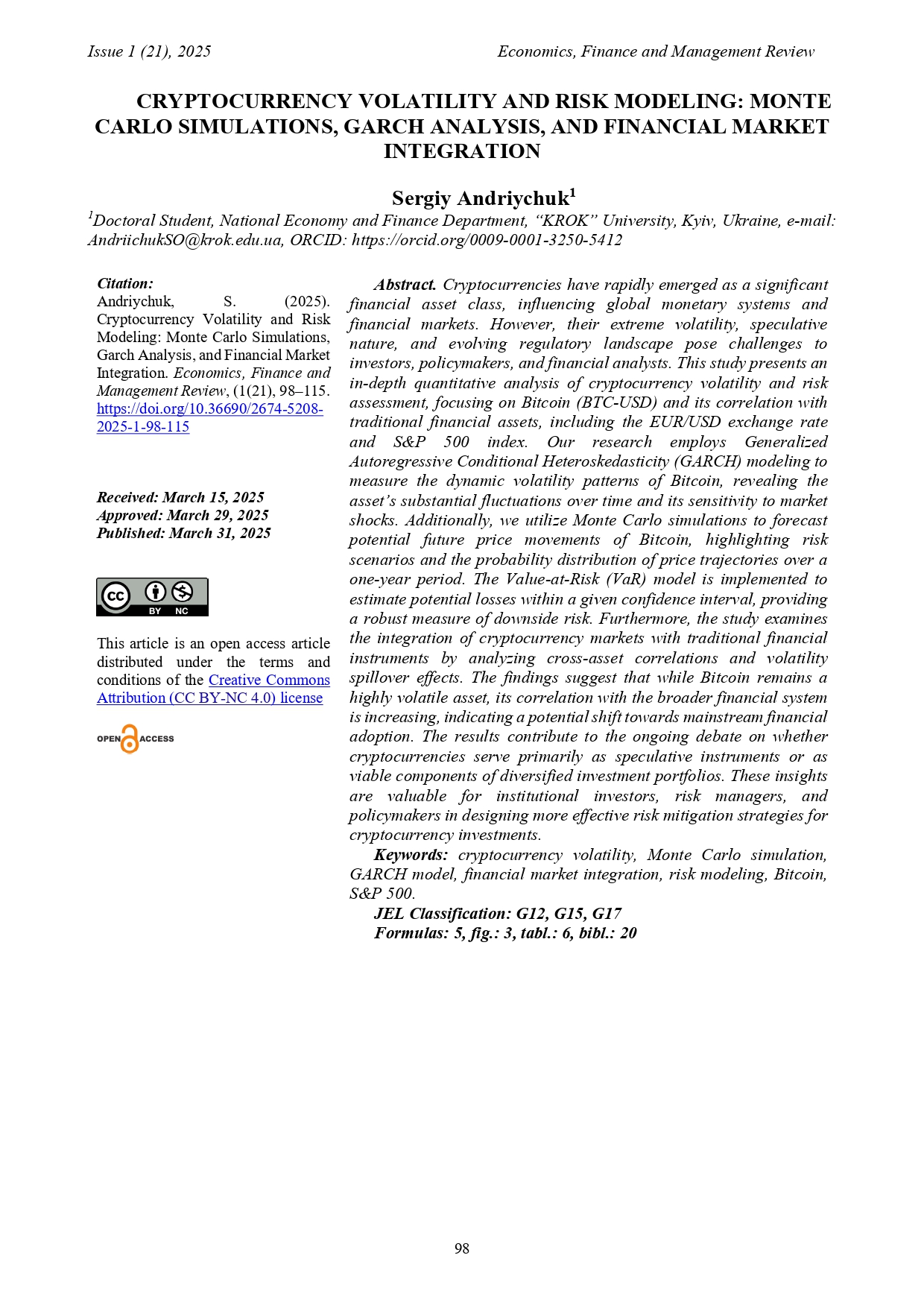CRYPTOCURRENCY VOLATILITY AND RISK MODELING: MONTE CARLO SIMULATIONS, GARCH ANALYSIS, AND FINANCIAL MARKET INTEGRATION
DOI:
https://doi.org/10.36690/2674-5208-2025-1-98-115Keywords:
cryptocurrency volatility, Monte Carlo simulation, GARCH model, financial market integration, risk modeling, Bitcoin, S&P 500Abstract
Cryptocurrencies have rapidly emerged as a significant financial asset class, influencing global monetary systems and financial markets. However, their extreme volatility, speculative nature, and evolving regulatory landscape pose challenges to investors, policymakers, and financial analysts. This study presents an in-depth quantitative analysis of cryptocurrency volatility and risk assessment, focusing on Bitcoin (BTC-USD) and its correlation with traditional financial assets, including the EUR/USD exchange rate and S&P 500 index. Our research employs Generalized Autoregressive Conditional Heteroskedasticity (GARCH) modeling to measure the dynamic volatility patterns of Bitcoin, revealing the asset’s substantial fluctuations over time and its sensitivity to market shocks. Additionally, we utilize Monte Carlo simulations to forecast potential future price movements of Bitcoin, highlighting risk scenarios and the probability distribution of price trajectories over a one-year period. The Value-at-Risk (VaR) model is implemented to estimate potential losses within a given confidence interval, providing a robust measure of downside risk. Furthermore, the study examines the integration of cryptocurrency markets with traditional financial instruments by analyzing cross-asset correlations and volatility spillover effects. The findings suggest that while Bitcoin remains a highly volatile asset, its correlation with the broader financial system is increasing, indicating a potential shift towards mainstream financial adoption. The results contribute to the ongoing debate on whether cryptocurrencies serve primarily as speculative instruments or as viable components of diversified investment portfolios. These insights are valuable for institutional investors, risk managers, and policymakers in designing more effective risk mitigation strategies for cryptocurrency investments.
Downloads
References
Albayati, H., Kim, S. K., & Rho, J. J. (2020). Accepting financial transactions using blockchain technology and cryptocurrency: A customer perspective approach. Technology in Society, 62, 101320. https://doi.org/10.1016/j.techsoc.2020.101320
Albrecht, C., Duffin, K. M., Hawkins, S., & Morales Rocha, V. M. (2019). The use of cryptocurrencies in the money laundering process. Journal of Money Laundering Control, 22(2), 210–216. https://doi.org/10.1108/jmlc-12-2017-0074
Allen, F., Gu, X., & Jagtiani, J. (2022). Fintech, Cryptocurrencies, and CBDC: Financial Structural Transformation in China. Journal of International Money and Finance, 124, 102625. https://doi.org/10.1016/j.jimonfin.2022.102625
Badawi, E., & Jourdan, G.-V. (2020). Cryptocurrencies Emerging Threats and Defensive Mechanisms: A Systematic Literature Review. IEEE Access, 8, 200021–200037. https://doi.org/10.1109/access.2020.3034816
Barnes, P. (2019). Crypto Currency and its Susceptibility to Speculative Bubbles, Manipulation, Scams and Fraud. Journal of Advanced Studies in Finance, 9(2), 60. https://doi.org/10.14505//jasf.v9.2(18).03
Binance Markets Overview. (2025). Binance. https://www.binance.com/uk-UA/markets/overview
Bommer, W. H., Milevoj, E., & Rana, S. (2022). The intention to use cryptocurrency: A meta-analysis of what we know. Emerging Markets Review, 100962. https://doi.org/10.1016/j.ememar.2022.100962
Bouri, E., Lau, C. K. M., Lucey, B., & Roubaud, D. (2019). Trading volume and the predictability of return and volatility in the cryptocurrency market. Finance Research Letters, 29, 340–346. https://doi.org/10.1016/j.frl.2018.08.015
Chu, J., Chan, S., Nadarajah, S., & Osterrieder, J. (2017). GARCH Modelling of Cryptocurrencies. Journal of Risk and Financial Management, 10(4), 17. https://doi.org/10.3390/jrfm10040017
Conrad, C., Custovic, A., & Ghysels, E. (2018). Long- and Short-Term Cryptocurrency Volatility Components: A GARCH-MIDAS Analysis. Journal of Risk and Financial Management, 11(2), 23. https://doi.org/10.3390/jrfm11020023
Dunn, B. (2024). Cryptocurrency: Still a Cause for Concern. Forum for Social Economics, 1–18. https://doi.org/10.1080/07360932.2024.2357364
Foley, S., Karlsen, J. R., & Putniņš, T. J. (2019). Sex, Drugs, and Bitcoin: How Much Illegal Activity Is Financed through Cryptocurrencies? The Review of Financial Studies, 32(5), 1798–1853. https://doi.org/10.1093/rfs/hhz015
García-Monleón, F., Erdmann, A., & Arilla, R. (2023). A value-based approach to the adoption of cryptocurrencies. Journal of Innovation & Knowledge, 8(2), 100342. https://doi.org/10.1016/j.jik.2023.100342
Nguyen, D. T. A., & Chan, K. C. (2024). Cryptocurrency trading: A systematic mapping study. International Journal of Information Management Data Insights, 4(2), 100240. https://doi.org/10.1016/j.jjimei.2024.100240
Samuele, B. (2023). Money in the Time of Crypto. Research in International Business and Finance, 101964. https://doi.org/10.1016/j.ribaf.2023.101964
Urquhart, A., & Yarovaya, L. (2023). Cryptocurrency research: Future directions. The European Journal of Finance, 1–6. https://doi.org/10.1080/1351847x.2023.2284186
Vasudeva, S. (2023). Cryptocurrency as an investment or speculation: A bibliometric review study. Business Analyst Journal. https://doi.org/10.1108/baj-07-2022-0008
Federal Reserve Economic Data (FRED). (n.d.). Federal Reserve Bank of St. Louis. Retrieved from https://fred.stlouisfed.org
Yahoo Finance. (n.d.). Yahoo Finance. Retrieved from https://finance.yahoo.com
Open Exchange Rates. (n.d.). Open Exchange Rates API. Retrieved from https://openexchangerates.org

Downloads
Published
How to Cite
Issue
Section
License

This work is licensed under a Creative Commons Attribution-NonCommercial 4.0 International License.








